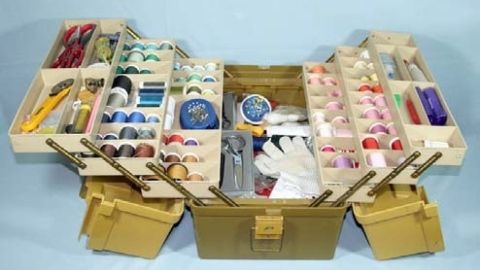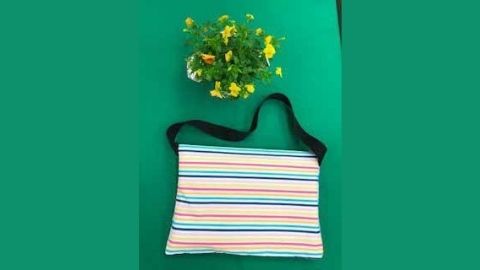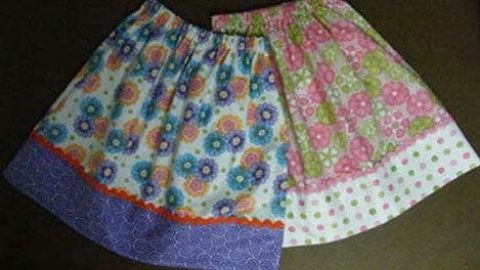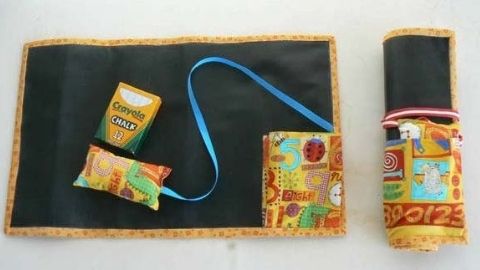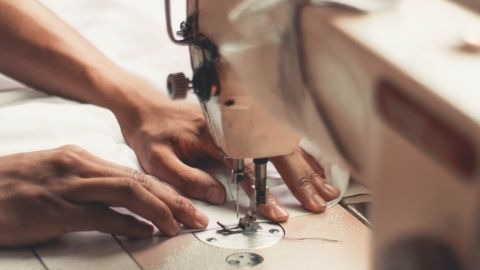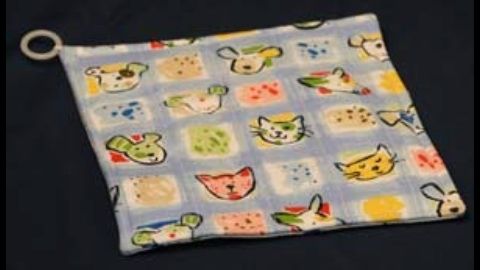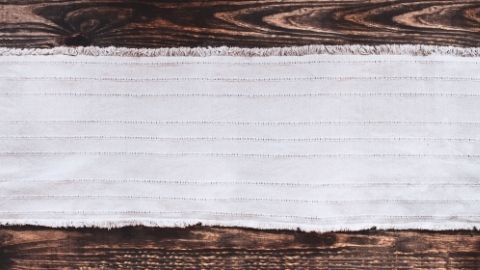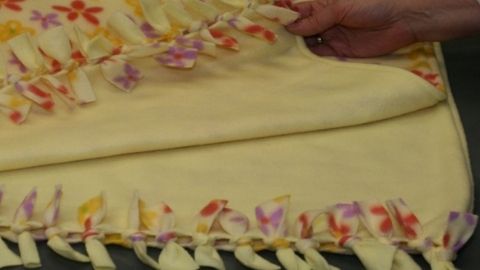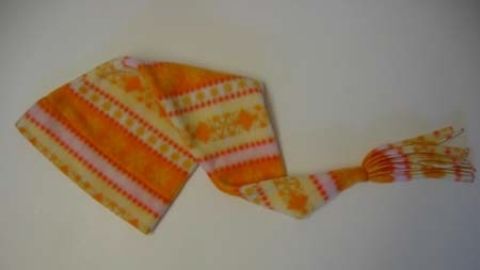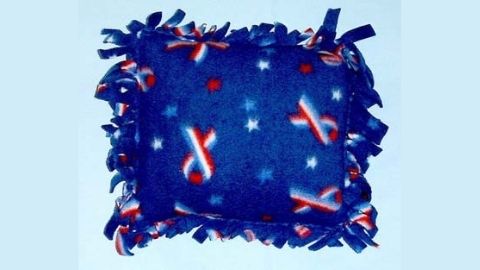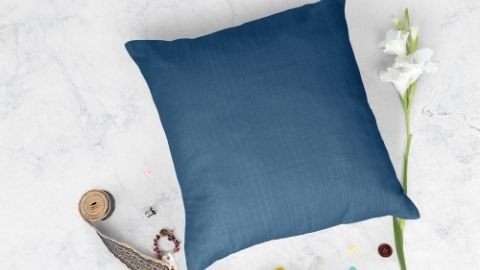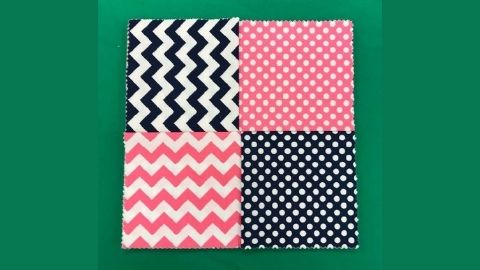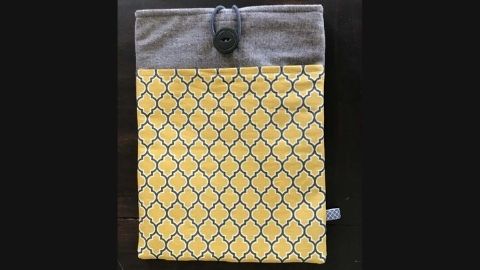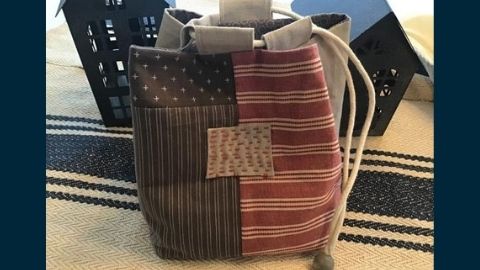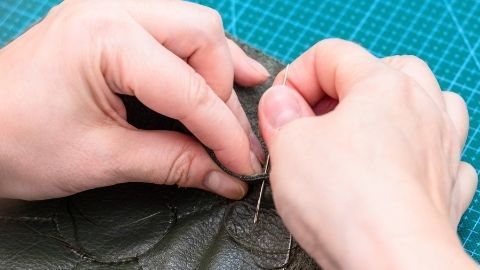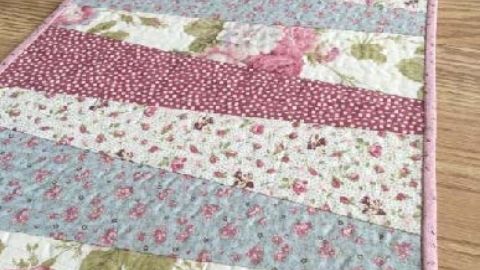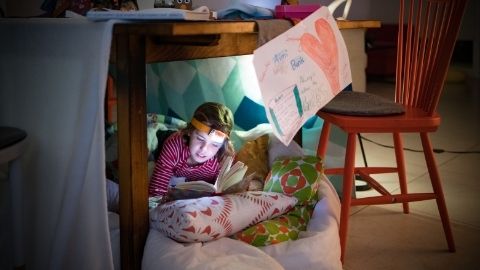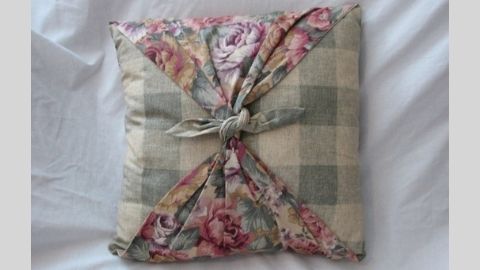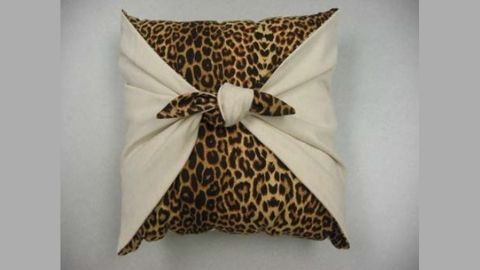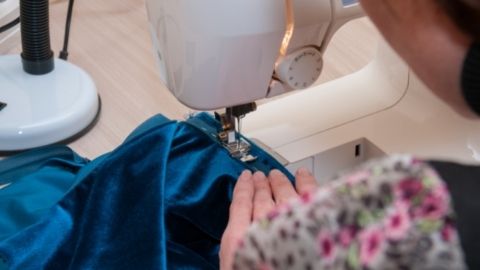Bordered Hem Skirt
The band of this skirt is made using the same method as the Designer Pillowcase. The band forms the hem of the skirt and gives the hem a nice weight. When finished the seam is enclosed. The width of the fabric and the desired amount of fullness will determine whether you can cut the skirt in one piece with a back seam or two pieces with side seams.
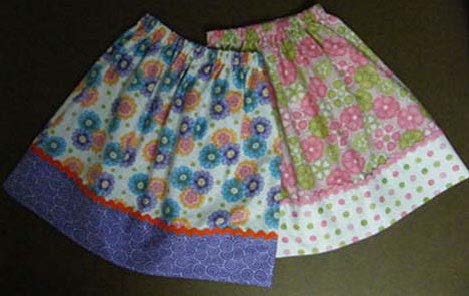 Supplies needed:
Supplies needed:
- Closely woven skirt weight fabric (amount will be determined by body measurements).
- 1/4-1/2 yard coordinating cotton/poly cotton fabric for border (amount will be determined by body measurements).
- 3/4" non-roll elastic to fit waist
- 2 yards rick rack or trim (width of skirt)
- Matching thread
- Safety pin or bodkin
- Basic Sewing Supplies (see Fact Sheet: FL/ST/Construction 2008/101)
Pattern markings:
Sewing clue—Becoming familiar with the markings in the Diagram Key will aid you in reading instructions. Most patterns have similar keys.
Diagram Key:
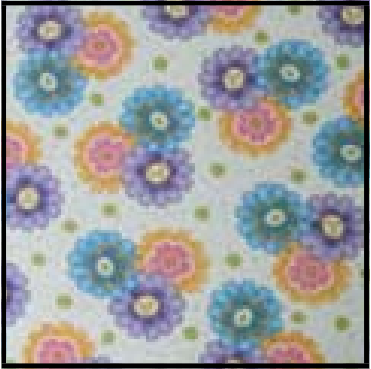
Right side of skirt

Right side of border
Determine the size of the skirt:
Step #1
- Take and record your measurements. It is best to work with a
partner. - For greater accuracy use a good tape measure, avoid taking
measurements over bulky clothing, and stand straight while being measured. - Tie a string snuggly not pinching around natural waist and
measure over the string keeping tape measure snug. Record your waist measurement. - Hip measurement is taken at the fullest part usually 7 to 9 inches below the waistline (this measurement will vary according to height and body build). Make sure that the tape measure remains parallel with the floor. Record your hip measurement.
- Measure from the string tied around the natural waistline down to the desired finished length. Record your length measurement.
Table 1
| Record Measurements | |
|---|---|
| Waist | |
| Hip | |
| Desired finished length |
|
Sewing clue — Wearing ease is the ease built into a pattern to make the finished garment comfortable to wear. Design ease is the ease in addition to the wearing ease which creates the overall outline or style of the finished garment. Wearing ease and design ease determine the fullness of the garment. Wearing ease of a garment is 1.2 times the hip measurement. The design ease of a garment is classified as being: semi-fitted, loose fitting, very loose, or extra loose. Ease equals the hip measurement times: 1.2, semi-fitted; 1.3, loose fitting; 1.5, very loose; and 2.0, extra loose. You can be the designer and select the desired ease for the fullness. For this skirt 1.8 times the hip measurement is recommended.
Step #2
- Determine how full you want your skirt.
- Record your hip measurement in Table 2.
- The skirt circumference and the width of the fabric will determine how much fabric you will need to purchase.
Table 2
| Skirt Width or Circumference | |||||||||
|---|---|---|---|---|---|---|---|---|---|
| This skirt is designed for two side seams using 44/45” width fabric. | |||||||||
| Hip Measurement (Table 1) |
X | Design Ease |
= | Skirt Circumference (inches) |
÷ | 2 | = | Width of Skirt Front and Back | |
| Sample | 29" | X | 1.8 | = | 52 | ÷ | 2 | = | 26" |
| Your Measurement | X | 1.8 | = | ÷ | 2 | = | |||
Table 6
| Skirt Length | |||||||||
|---|---|---|---|---|---|---|---|---|---|
| Determine the length of skirt. | |||||||||
| Desired Finished Skirt length = ______ (Table 1) Finished band length = ___4″___ . Note—round to the nearest 1/2 inch |
|||||||||
| 6A: Skirt | Desired Finished Skirt Length | - | Length of Band | + | Casing | + | Seam Allowance | = | Length of Skirt Piece |
| Sample | 22” | - | 4" | + | 1 1/2" | + | 1/2″ | = | 20″ |
| Your Measurement | - | 4" | + | 1 1/2" | + | 1/2″ | = | ||
Cutting instructions:
Step #1
Dimensions for skirt piece:
- Width of skirt piece: Table 2.
- Length of skirt piece: Table 6A.
- From the skirt fabric—cut two
- Skirt pieces: ______ Width by ______ Length
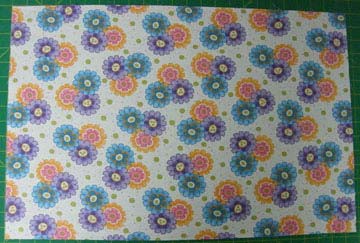
Step #2
Dimensions for border:
- Width of band piece: Table 2. (same as skirt piece)
- Length of band piece: 9″ (2 X 4 +1=9) (the band is doubled)
- From the border fabric—cut two
- Border pieces: ______ Width by ______ Length
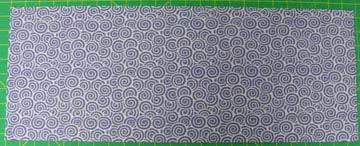
Skirt Construction:
Step #1
- Finish the side seam edges on the body of the skirt. The border pieces do not need seam finishes.
- For skirts with more than one seam, sew one side seam from top to bottom using a ½"seam allowance.
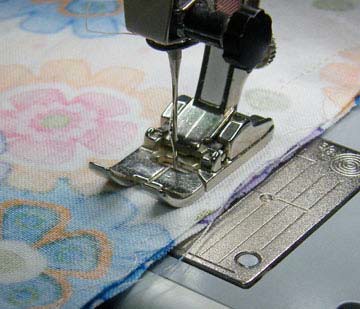
Step #2
- Press sewn side seam flat to set the stitches and then press the seam open.
Sewing clue—Press along the stitching line on both sides before
pressing the seam open to set the stitches. This makes it easier
to press the seam open and helps the seam lay smoothly.


Step #3
- Take the two border pieces and seam the two together using a ½" seam. This seam will be enclosed so no seam finish is necessary.
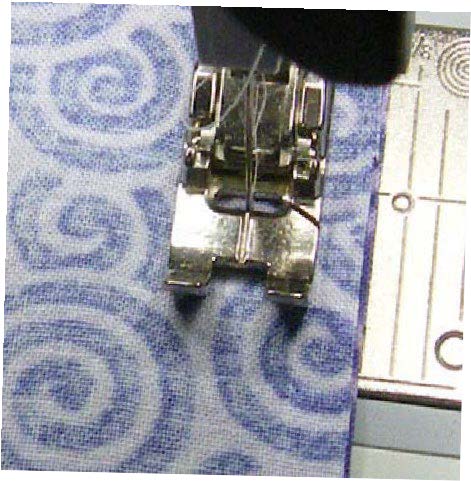
Step #4
- Press the seam flat to set the stitches and the press the seam open.
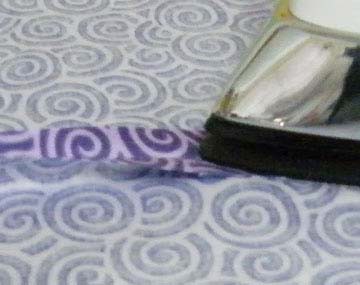
Step #5
- Lay coordinating border on a flat surface with right-side up. Place the right side of the skirt on the right-side of the coordinating border, matching raw edges. Pin edges together.
Sewing clue—Place pins at a right angle to the cut edge of the fabric. The head of the pin should extend beyond the cut edge. This allows the pin to be easily removed just before the presser foot reaches the pin. Do not sew over pins; they can break or dull the needle.
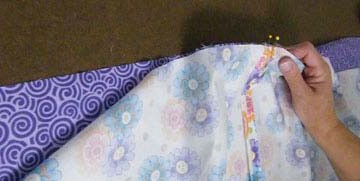
Step #6
- Sew 5" in on each end with a ½"seam allowance. Mark the end of your seam with a pin. Back stitch at beginning an end.
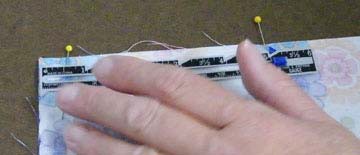
Step #7
- Roll the width of the skirt toward the pinned edge. Stop rolling when you reach the center of the border fabric.
Step #8
- Wrap coordinating border edge fabric aroundrolled skirt body. Match the raw edges at the top of the border piece.
- Sew a ½" seam allowance along the pinned edge starting five inches in and stopping five inches from the end at the marked pin. Back stitch three or four stitches at beginning and end.
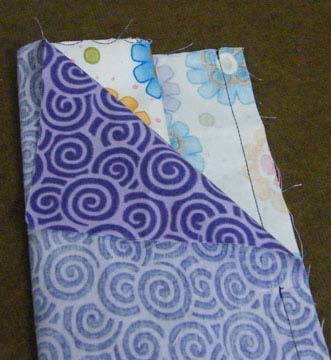
Sewing clue—pin along the roll, about 1 ½ " in from the cut edge. Take care not to sew the skirt roll into the seam. Check to see that all layers of the seam are caught before turning
Step #9
- Press seam flat.
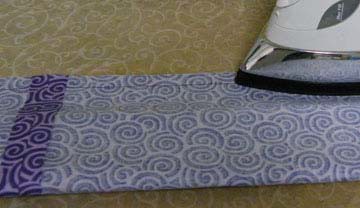
Step #10
- Reach into the sewn tube and pull the skirt body out through the side opening. The skirt and coordinating border edge is now right-side out.
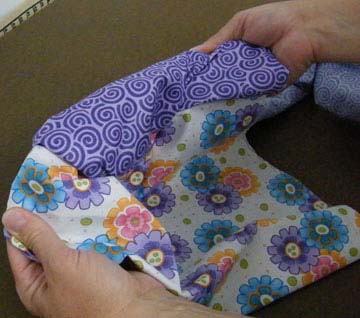
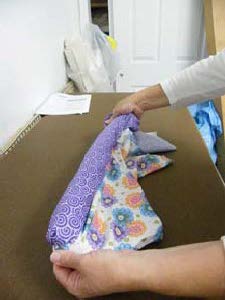
Step #11
- Press seam flat on both sides until the seam lays flat eliminating wrinkles.
Sewing clue—Pressing is an important part of sewing to shape and set the stitches. Press after stitching each seam. You will be able to stitch the next step smoothly and evenly, and your article will have a more professional look.
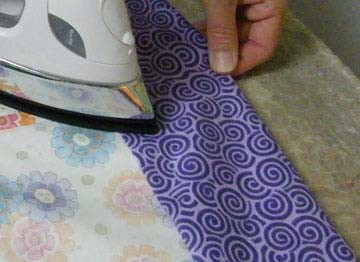
Step #12
- Pin the side seam, right sides together making a circle. Match up the raw edges. Match the seam at the top of the border, pin in place, continue to pin the length of the side seam and border.
- Sew a ½" seam down the body of the skirt and the border."

Step #13
- Press the seam flat and then open as far down the seam as possible.

Step #14
- Check the inside of the seam to make sure it is open all the way to the bottom of the seam. Turn skirt right side out. Tuck the seam allowance under on the top edge of the border to the inside of the band to finish off.
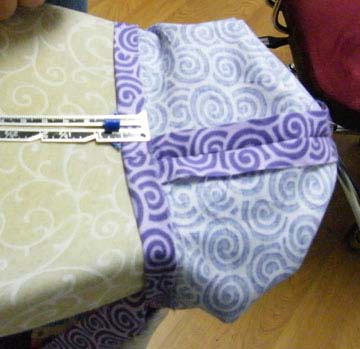
Step #15
- Press the top of the border. Pin border in place. Blind hemthe opening closed or you can stitch in the ditch. If you plan to use a trim you can close this opening when you top stitch the trim on.
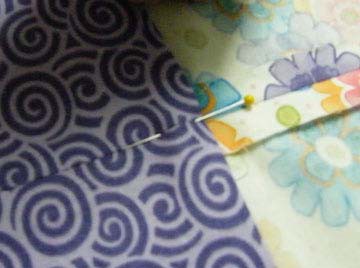
Step #16
- Pin or use a water soluble glue stick to place rick rack or trim to skirt. Center over the seam between skirt and border.

Step #17
- Draw a line with a marker down the middle of the rick rack to help sew it on straight.

Step #18
- Sew rick rack or trim in place using a straight stitch. Fold under the raw edge when the rick rack or trim meets at the beginning. Try to match the beginning.
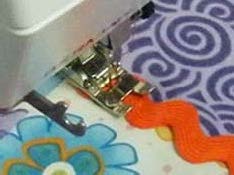
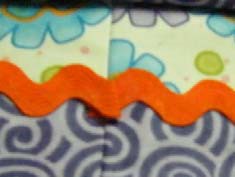
Step #19
- Fold the top edge of the skirt down ½" and press flat. Turndown a second time 1¼". Pin and press flat.
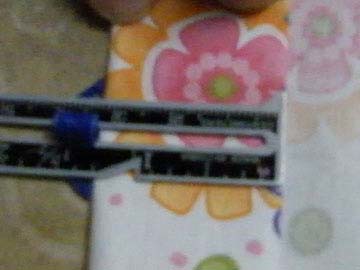
Step #20
- Use the topstitching foot or the hem foot. Move the needle to the left position and sew next to the edge of the top fold. This helps to prevent the elastic from rolling.
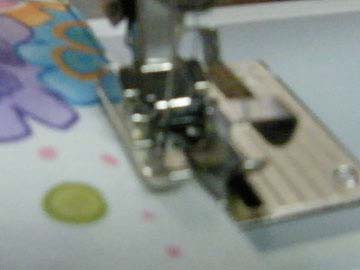
Step #21
- Sew the bottom of the casing. Leave a 1" opening at a side seam and use the hem foot as a guide to sew next to the bot- tom fold. Move the needle to the right position. Back stitch three to four stitches at the beginning and end.
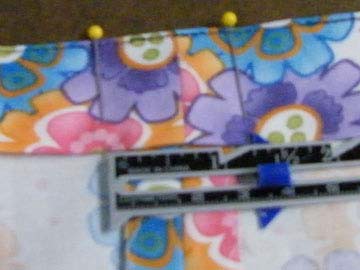

Step #22
- Pin a safety pin to one end of the elastic and a long straight pin at the other end. Use the safety pin or a bodkin and thread the elastic through the casing of the skirt. Be careful not to twist the elastic.
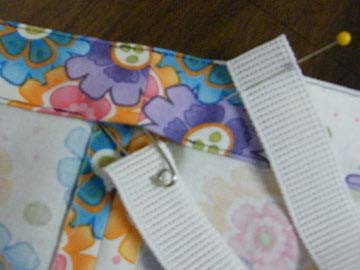
Step #23
- Match up the two ends of the elastic, overlapping the ends making a complete circle. Overlap the elastic and sew an ‘X’ and backstitch.

Step #24
- Tuck the elastic into the casing and sew the opening closed.
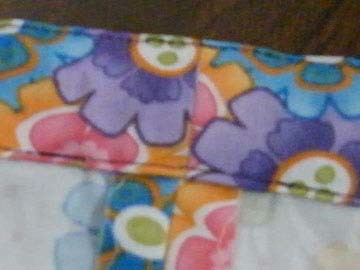
Step #25
- Give the skirt an all over press


Bordered Hem Skirt for 18" Doll
Supplies needed:
- 1/4 yard coordinating cotton/poly cotton fabric for skirt
- 1/8 yard coordinating cotton/poly cotton fabric for bordered hem
- 1/2" nonroll elastic to fit waist (approximately 11")
- 22" rick rack or trim
- Matching thread
- Safety pin or bodkin
- Basic Sewing Supplies (see Fact Sheet: FL/ST/Construction 2008/101)
Cutting instructions:
Step 1:
- Skirt fabric:
- Cut one rectangle piece 22" X 6 1/2"
Skirt construction:
Step 1:
- Follow steps for skirt construction as outlined in Bordered Hem Skirt.


Authors
Susan Haws, USU Extension Agent, Summit County; Debra Proctor, USU Extension Agent, Wasatch County
Related Research


 Utah 4-H & Youth
Utah 4-H & Youth